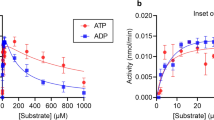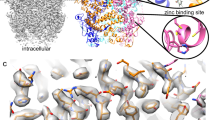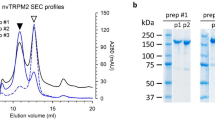Abstract
Transient receptor potential melastatin 2 (TRPM2) is a ligand-gated Ca2+-permeable nonselective cation channel. Whereas physiological stimuli, such as chemotactic agents, evoke controlled Ca2+ signals via TRPM2, pathophysiological stimuli such as reactive oxygen species and genotoxic stress result in prolonged TRPM2-mediated Ca2+ entry and, consequently, apoptosis. To date, adenosine 5′-diphosphoribose (ADPR) has been assumed to be the main agonist for TRPM2. Here we show that 2′-deoxy-ADPR was a significantly better TRPM2 agonist, inducing 10.4-fold higher whole-cell currents at saturation. Mechanistically, this increased activity was caused by a decreased rate of inactivation and higher average open probability. Using high-performance liquid chromatography (HPLC) and mass spectrometry, we detected endogenous 2′-deoxy-ADPR in Jurkat T lymphocytes. Consistently, cytosolic nicotinamide mononucleotide adenylyltransferase 2 (NMNAT-2) and nicotinamide adenine dinucleotide (NAD)-glycohydrolase CD38 sequentially catalyzed the synthesis of 2′-deoxy-ADPR from nicotinamide mononucleotide (NMN) and 2′-deoxy-ATP in vitro. Thus, 2′-deoxy-ADPR is an endogenous TRPM2 superagonist that may act as a cell signaling molecule.
This is a preview of subscription content, access via your institution
Access options
Access Nature and 54 other Nature Portfolio journals
Get Nature+, our best-value online-access subscription
$29.99 / 30 days
cancel any time
Subscribe to this journal
Receive 12 print issues and online access
$259.00 per year
only $21.58 per issue
Buy this article
- Purchase on Springer Link
- Instant access to full article PDF
Prices may be subject to local taxes which are calculated during checkout






Similar content being viewed by others
References
Perraud, A.L. et al. ADP-ribose gating of the calcium-permeable LTRPC2 channel revealed by Nudix motif homology. Nature 411, 595–599 (2001).
Knowles, H., Li, Y. & Perraud, A.L. The TRPM2 ion channel, an oxidative stress and metabolic sensor regulating innate immunity and inflammation. Immunol. Res. 55, 241–248 (2013).
Faouzi, M. & Penner, R. in Mammalian Transient Receptor Potential (TRP) Cation Channels Vol. 222 (eds. Nilius, B. & Flockerzi, V.) 403–426 (Springer, 2014).
Gasser, A. et al. Activation of T cell calcium influx by the second messenger ADP-ribose. J. Biol. Chem. 281, 2489–2496 (2006).
Buelow, B., Song, Y. & Scharenberg, A.M. The Poly(ADP-ribose) polymerase PARP-1 is required for oxidative stress-induced TRPM2 activation in lymphocytes. J. Biol. Chem. 283, 24571–24583 (2008).
Partida-Sanchez, S. et al. Chemotaxis of mouse bone marrow neutrophils and dendritic cells is controlled by ADP-ribose, the major product generated by the CD38 enzyme reaction. J. Immunol. 179, 7827–7839 (2007).
Uchida, K. et al. Lack of TRPM2 impaired insulin secretion and glucose metabolisms in mice. Diabetes 60, 119–126 (2011).
Song, K. et al. The TRPM2 channel is a hypothalamic heat sensor that limits fever and can drive hypothermia. Science 353, 1393–1398 (2016).
Tan, C.-H. & McNaughton, P.A. The TRPM2 ion channel is required for sensitivity to warmth. Nature 536, 460–463 (2016).
Wehage, E. et al. Activation of the cation channel long transient receptor potential channel 2 (LTRPC2) by hydrogen peroxide. A splice variant reveals a mode of activation independent of ADP-ribose. J. Biol. Chem. 277, 23150–23156 (2002).
Du, J., Xie, J. & Yue, L. Intracellular calcium activates TRPM2 and its alternative spliced isoforms. Proc. Natl. Acad. Sci. USA 106, 7239–7244 (2009).
Grubisha, O. et al. Metabolite of SIR2 reaction modulates TRPM2 ion channel. J. Biol. Chem. 281, 14057–14065 (2006).
Moreau, C. et al. Structure-activity relationship of adenosine 5′-diphosphoribose at the transient receptor potential melastatin 2 (TRPM2) channel: rational design of antagonists. J. Med. Chem. 56, 10079–10102 (2013).
Tóth, B., Iordanov, I. & Csanády, L. Ruling out pyridine dinucleotides as true TRPM2 channel activators reveals novel direct agonist ADP-ribose-2′-phosphate. J. Gen. Physiol. 145, 419–430 (2015).
Sano, Y. et al. Immunocyte Ca2+ influx system mediated by LTRPC2. Science 293, 1327–1330 (2001).
Beck, A., Kolisek, M., Bagley, L.A., Fleig, A. & Penner, R. Nicotinic acid adenine dinucleotide phosphate and cyclic ADP-ribose regulate TRPM2 channels in T lymphocytes. FASEB J. 20, 962–964 (2006).
Klumpp, D. et al. Targeting TRPM2 channels impairs radiation-induced cell cycle arrest and fosters cell death of T cell leukemia cells in a Bcl-2-dependent manner. Oxid. Med. Cell. Longev. 2016, 8026702 (2016).
Brown, L.A., Ihara, M., Buckingham, S.D., Matsuda, K. & Sattelle, D.B. Neonicotinoid insecticides display partial and super agonist actions on native insect nicotinic acetylcholine receptors. J. Neurochem. 99, 608–615 (2006).
Mortensen, M., Ebert, B., Wafford, K. & Smart, T.G. Distinct activities of GABA agonists at synaptic- and extrasynaptic-type GABAA receptors. J. Physiol. (Lond.) 588, 1251–1268 (2010).
Tóth, B. & Csanády, L. Pore collapse underlies irreversible inactivation of TRPM2 cation channel currents. Proc. Natl. Acad. Sci. USA 109, 13440–13445 (2012).
Csanády, L. & Törocsik, B. Four Ca2+ ions activate TRPM2 channels by binding in deep crevices near the pore but intracellularly of the gate. J. Gen. Physiol. 133, 189–203 (2009).
Klenow, H. & Andersen, B. Some enzyme reactions with adenine deoxyriboside polyphosphates. Biochim. Biophys. Acta 23, 92–97 (1957).
Emanuelli, M. et al. Molecular cloning, chromosomal localization, tissue mRNA levels, bacterial expression, and enzymatic properties of human NMN adenylyltransferase. J. Biol. Chem. 276, 406–412 (2001).
Di Stefano, M. & Conforti, L. Diversification of NAD biological role: the importance of location. FEBS J. 280, 4711–4728 (2013).
Suhadolnik, R.J. et al. ADP-ribosylation of isolated nuclei from HeLa cells, rat liver, fetal rat liver, and Novikoff rat hepatoma: effect of nicotinamide adenine dinucleotide analogs on template activity for DNA synthesis, incorporation into nuclear proteins, and a new 1″→3′ osidic linkage. J. Biol. Chem. 252, 4134–4144 (1977).
Bakondi, E. et al. Detection of poly(ADP-ribose) polymerase activation in oxidatively stressed cells and tissues using biotinylated NAD substrate. J. Histochem. Cytochem. 50, 91–98 (2002).
Zhao, Y.J., Lam, C.M.C. & Lee, H.C. The membrane-bound enzyme CD38 exists in two opposing orientations. Sci. Signal. 5, ra67 (2012).
Muller-Steffner, H.M., Malver, O., Hosie, L., Oppenheimer, N.J. & Schuber, F. Slow-binding inhibition of NAD+ glycohydrolase by arabino analogues of β-NAD. J. Biol. Chem. 267, 9606–9611 (1992).
Mali, P. et al. RNA-guided human genome engineering via Cas9. Science 339, 823–826 (2013).
Cong, L. et al. Multiplex genome engineering using CRISPR/Cas systems. Science 339, 819–823 (2013).
Hara, Y. et al. LTRPC2 Ca2+-permeable channel activated by changes in redox status confers susceptibility to cell death. Mol. Cell 9, 163–173 (2002).
Heiner, I. et al. Expression profile of the transient receptor potential (TRP) family in neutrophil granulocytes: evidence for currents through long TRP channel 2 induced by ADP-ribose and NAD. Biochem. J. 371, 1045–1053 (2003).
Fonfria, E. et al. TRPM2 channel opening in response to oxidative stress is dependent on activation of poly(ADP-ribose) polymerase. Br. J. Pharmacol. 143, 186–192 (2004).
Rosenbluth, M.J., Lam, W.A. & Fletcher, D.A. Force microscopy of nonadherent cells: a comparison of leukemia cell deformability. Biophys. J. 90, 2994–3003 (2006).
Ashamu, G.A., Sethi, J.K., Galione, A. & Potter, B.V.L. Roles for adenosine ribose hydroxyl groups in cyclic adenosine 5′-diphosphate ribose-mediated Ca2+ release. Biochemistry 36, 9509–9517 (1997).
Moreau, C. et al. Synthesis of cyclic adenosine 5′-diphosphate ribose analogues: a C2′ endo/syn “southern” ribose conformation underlies activity at the sea urchin cADPR receptor. Org. Biomol. Chem. 9, 278–290 (2011).
Del Nagro, C., Xiao, Y., Rangell, L., Reichelt, M. & O'Brien, T. Depletion of the central metabolite NAD leads to oncosis-mediated cell death. J. Biol. Chem. 289, 35182–35192 (2014).
Dahmen, W., Webb, B. & Preiss, J. The deamido-diphosphopyridine nucleotide and diphosphopyridine nucleotide pyrophosphorylases of Escherichia coli and yeast. Arch. Biochem. Biophys. 120, 440–450 (1967).
Suhadolnik, R.J., Lennon, M.B., Uematsu, T., Monahan, J.E. & Baur, R. Role of adenine ring and adenine ribose of nicotinamide adenine dinucleotide in binding and catalysis with alcohol, lactate, and glyceraldehyde-3-phosphate dehydrogenases. J. Biol. Chem. 252, 4125–4133 (1977).
Schuber, F., Pascal, M. & Travo, P. Calf-spleen nicotinamide-adenine dinucleotide glycohydrolase. Properties of the active site. Eur. J. Biochem. 83, 205–214 (1978).
Xie, Y.F., Macdonald, J.F. & Jackson, M.F. TRPM2, calcium and neurodegenerative diseases. Int. J. Physiol. Pathophysiol. Pharmacol. 2, 95–103 (2010).
Fonfria, E. et al. TRPM2 is elevated in the tMCAO stroke model, transcriptionally regulated, and functionally expressed in C13 microglia. J. Recept. Signal Transduct. Res. 26, 179–198 (2006).
Yang, K.-T. et al. Activation of the transient receptor potential M2 channel and poly(ADP-ribose) polymerase is involved in oxidative stress-induced cardiomyocyte death. Cell Death Differ. 13, 1815–1826 (2006).
Zhang, B. et al. 2′-deoxy cyclic adenosine 5′-diphosphate ribose derivatives: importance of the 2′-hydroxyl motif for the antagonistic activity of 8-substituted cADPR derivatives. J. Med. Chem. 51, 1623–1636 (2008).
Kirchberger, T. et al. 8-Bromo-cyclic inosine diphosphoribose: towards a selective cyclic ADP-ribose agonist. Biochem. J. 422, 139–149 (2009).
He, B. & Soderlund, D.M. Human embryonic kidney (HEK293) cells express endogenous voltage-gated sodium currents and Na v 1.7 sodium channels. Neurosci. Lett. 469, 268–272 (2010).
Gagné, J.P. et al. Quantitative proteomics profiling of the poly(ADP-ribose)-related response to genotoxic stress. Nucleic Acids Res. 40, 7788–7805 (2012).
Bobalova, J., Bobal, P. & Mutafova-Yambolieva, V.N. High-performance liquid chromatographic technique for detection of a fluorescent analogue of ADP-ribose in isolated blood vessel preparations. Anal. Biochem. 305, 269–276 (2002).
Schmid, F., Fliegert, R., Westphal, T., Bauche, A. & Guse, A.H. Nicotinic acid adenine dinucleotide phosphate (NAADP) degradation by alkaline phosphatase. J. Biol. Chem. 287, 32525–32534 (2012).
Schmid, F., Bruhn, S., Weber, K., Mittrücker, H.W. & Guse, A.H. CD38: a NAADP degrading enzyme. FEBS Lett. 585, 3544–3548 (2011).
Acknowledgements
This study was supported by the Deutsche Forschungsgemeinschaft (GU 360/16-1 to A.H.G.), the Wellcome Trust (Project Grant 084068 to B.V.L.P. and A.H.G.; Programme Grant 082837 to B.V.L.P.) and Landesforschungsförderung Hamburg (Research Group ReAd Me to A.H.G.). B.V.L.P. is a Wellcome Trust Senior Investigator (grant 101010). Wild-type HEK293 cells were kindly provided by M. Jücker (Department of Biochemistry and Signal Transduction, University Medical Centre Hamburg–Eppendorf, Hamburg, Germany). Expression plasmids pX330-Puro-T2A-hCas9 and pCAG-EGxxFP were kindly provided by A. Flügel (Department of Neuroimmunology, University Medical Center Göttingen, Göttingen, Germany).
Author information
Authors and Affiliations
Contributions
A.H.G., B.V.L.P. and R.F. designed the study and individual experiments. C.M. and J.M.W. synthesized and purified the ADPR analogs. T.K., R.F. and M.D.R. performed electrophysiological characterization of ADPR analogs. M.D.R. carried out the single-channel recordings. A.-M.W.P. and A.B. performed the enzyme assays with NMNAT and CD38. R.W. analyzed nucleotide products from poly-ADP ribosylated proteins. R.F. and A.H. prepared TRPM2 T5L and CD38 expression vectors and generated the TRPM2 T5L cell line. A.B., A.-M.W.P. and M.J. established the HPLC method for the determination of endogenous 2′-deoxy-ADPR. A.B. and M.J. quantitatively analyzed endogenous nucleotides. A.B. determined substrate saturation plots for NMNAT-2 and sCD38. J.M.W. carried out high-resolution mass spectrometry analysis of 2′-deoxy-ADPR and 2′-deoxy-NAD. V.W. generated the CD38−/− Jurkat cell line and produced and purified soluble recombinant CD38. M.F. characterized the CD38−/− Jurkat cell line. A.R., A.B. and F.G. determined the activity of CD38 in type III orientation. All authors wrote the manuscript.
Corresponding author
Ethics declarations
Competing interests
The authors declare no competing financial interests.
Supplementary information
Supplementary Text and Figures
Supplementary Results and Supplementary Figures 1–15 (PDF 2418 kb)
Rights and permissions
About this article
Cite this article
Fliegert, R., Bauche, A., Wolf Pérez, AM. et al. 2′-Deoxyadenosine 5′-diphosphoribose is an endogenous TRPM2 superagonist. Nat Chem Biol 13, 1036–1044 (2017). https://doi.org/10.1038/nchembio.2415
Received:
Accepted:
Published:
Issue Date:
DOI: https://doi.org/10.1038/nchembio.2415
This article is cited by
-
Targeted metabolomics detects a putatively diagnostic signature in plasma and dried blood spots from head and neck paraganglioma patients
Oncogenesis (2023)
-
New Insights on the Role of TRP Channels in Calcium Signalling and Immunomodulation: Review of Pathways and Implications for Clinical Practice
Clinical Reviews in Allergy & Immunology (2021)
-
Silica nanoparticles induce lung inflammation in mice via ROS/PARP/TRPM2 signaling-mediated lysosome impairment and autophagy dysfunction
Particle and Fibre Toxicology (2020)
-
Different substrate specificities of the two ADPR binding sites in TRPM2 channels of Nematostella vectensis and the role of IDPR
Scientific Reports (2019)
-
TRPM2: a candidate therapeutic target for treating neurological diseases
Acta Pharmacologica Sinica (2018)



